
Found It
I drive through Flemington NJ a couple of times every week. Up at the end of downtown, a couple blocks past the famous old courthouse, is the town’s little war memorial park. It’s on a little triangular island of land where three or four roads come together, right in front of the Presbyterian church. Like so many of them do, ours started out as a memorial to those who served in the Civil War but has had inscriptions added for each of the conflicts since. So it has a nice statue on a fancy plinth, a little walk around reflecting area, a flagpole, and of course an old cannon, pointing straight down Main Street. I don’t think anyone actually goes into the park to visit because it’s in the middle of a busy intersection, but we all see it all the time.
And for years I’ve been driving past it, and looking at that strange old cannon, and wondering what it was and when it was from. I’m no master of historic artillery, but I can tell the 1770s guns from the 1860s guns, and I can tell the difference between a naval gun, a coastal piece, and a field piece. (Ok, I also know a bit about Armstrong, Whitworth, Parrot, Borgard, Buffington, and the burst-proof laminated iron guns made by the good old Phoenix Iron Company who later used the same technology to make all those gorgeous little bridges around my county.) But this one always looked strange to me because it has an iron frame and what look like spring loaded hanging hooks sticking up above the carriage. It’s always been in the back of my mind to visit that little park one day, and see if I can’t read some maker’s data on the gun. But that never seemed to happen, and late last night I realized I really didn’t need to: I’ve got the whole world right here on my keyboard. Besides, my camera is still hiding in some box in the garage from when we moved, and it’s cold out. And snowing!! So start searching Drew.
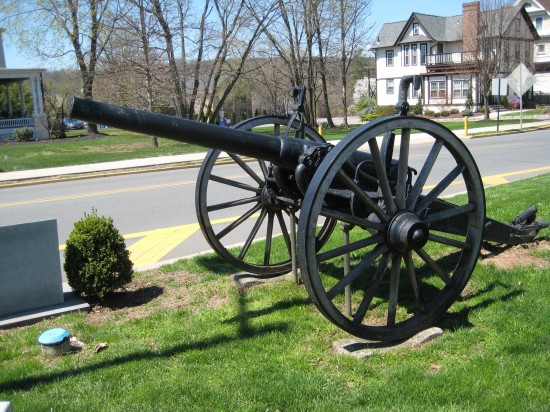
Ok, what do I know? I know the carriage is made of metal, steel or iron, not wood, so this is probably post-Civil War design. So I started trying to Google up “cannon” and “field piece” with various dates. I also knew that by 1915 the US was using fully modern artillery, so my time range was 1870-1900. And I looked and I looked, and found everything under the sun except what I wanted. So it was back to square one. Hmmph. Ok, where is this thing? It’s in a park in Flemington. Fine, let’s Google “Flemington park cannon” ... and that started me in the right direction. It turns out that there are tons of little web pages made by folks who have a hobby called geo caching, where they go somewhere interesting, take down the coordinates on their GPS, then publish that location with some bit of a clue or a few pictures for others to go and take a look. And those that do, write comments on that page and a big discussion ensues. So I found one of those, and it lead me realize, DUH, that in this simplified age, the little park would be called a Soldier’s Monument instead of a War Memorial. Plug in those words. And ta-da. Mostly. A fellow UTwp resident had made a nice web page on the park, with a good picture of the field piece (I borrowed it above) and the thought that this was a 3” gun from the Spanish-American War. And he was right, mostly. The gun was actually from before the S-A War, had a 3.2” bore, and was technically obsolete when we sent it down there. But hey, so were our rifles and our food and our logistics and our medicine. That little war was the biggest FUBAR of the age. And with a bit more looking, I finally opened the floodgates. Heck, I found the user’s manual. I found the builder’s specs. I found photos of similar ones. And I even found a video of a bunch of 21st Century Americans literally having a blast shooting off real antique cannons which they own, shooting full power loads, with explosive shells. Legally. Was this a great country once or what?
The rest of the story below the fold, because this post will be long. But I’ll put in lots of pictures and data and links so hopefully it won’t be too boring. I hope. The whole post is another one of my “interesting history is all around you, open your eyes and amaze yourself at what you can learn if you try” posts.
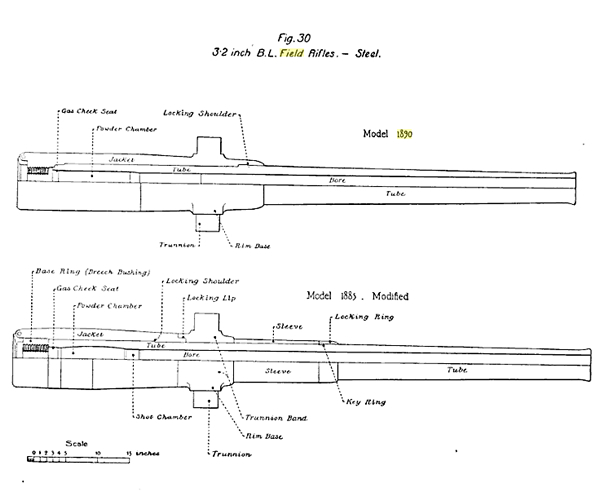
Observe that this gun, a 3.2 inch breech loading rifle, model 1890, is put together in layers, similar to the Whitworth Rifle of the Civil War. The tube, ie the barrel or the “shooty part” is inserted into a sleeve or jacket, and the sleeve adds extra strength to the firing chamber, ie the “bangy part”. This is how artillery pieces are still made today, in layers of steel. Notice that the sleeve forward of the trunnion (the round stubby hinge pins where the gun tube attaches to the carriage) is much longer and two pieces on the 1895 gun, but shorter and only one piece on the 1890 gun. Better steel, better technology. Steel was really coming into it’s own right when this gun was designed, so technology was advancing rapidly. Google found me part of a nice old book that shows how it works, how to work the gun, and even how much powder to feed the beast to fire it’s 13.5lb shell more than 4,500 yards. Coolness.
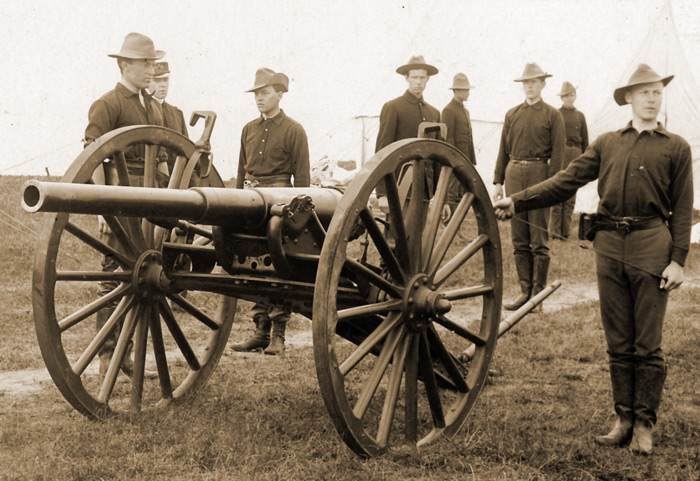
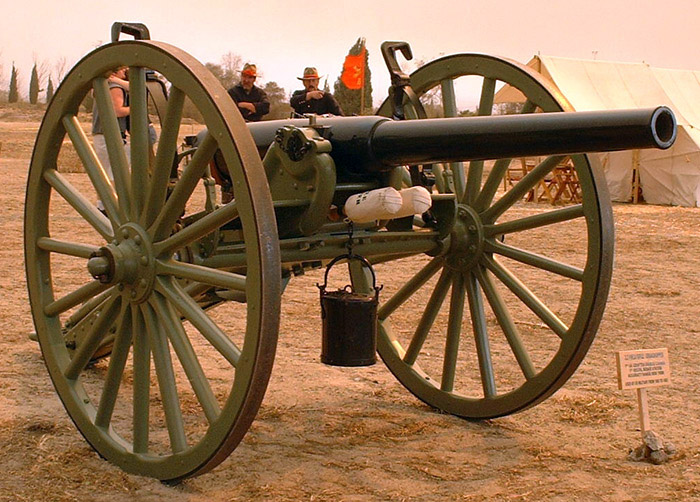
1st pic: Model 1885; 2nd pic: model 1890 See the difference in the forward part of the barrel sleeve?
The marvelously named website Fields of Thunder had the above pictures and more, plus some interesting information on the gun. See, what makes it interesting is that this is another transitional piece. It’s not quite one thing or the other. It’s a rifled breech loading gun, using a modern interrupted screw breech block, but it didn’t use fixed ammunition (ie a cartridge). It had a very primitive recoil compensation system - the French didn’t invent the hydro-pneumatic system used to this day until 1897 and they kept it secret for a while. That’s the spring hook things you see sticking up in the photos. What an ingenious but ineffective solution; you’d almost think Colonel Buffington had a hand in the design. But it worked a little. Instead of the cannon jumping back several feet on firing and then having to be re-aimed, the springs hooked to the wheel rims and kept the wheels from turning. Much. So the gun would only jump back a foot, and then wobble back and forth a few times. The springs didn’t absorb any recoil at all, they just caused the wheels to roll forward the same amount that they’d rolled backwards. And that was good enough for the era.
The newly designed 1885 3.2 Field Gun, unlike its predecessor the 3” Ordinance rifle (a front muzzle loading gun), was developed to load from the rear. This enabled the crew to load and fire at a more rapid rate. Its Indian War Era service record includes Wounded Knee in 1890. This gun was used in the Spanish American War battle at Santiago de Cuba and the Philippine Insurrection.
These breech loading unique weapons were the 1st to use dampening recoil brake systems throwing the gun forward and back, giving it the nickname “grasshopper”.
So it’s quite obvious that the photo with the gun crew above is staged. The wheel brakes aren’t hooked up. And with that limber pole (aka trail handspike) still in place, I feel sorry for the soldier standing behind the gun if his buddy pulls the lanyard. Ouch! Fields of Thunder has a picture with the brakes properly set for firing.
There are two brakes, one for each wheel.
The brake consists of two bow springs with their concave sides toward each other, assembled at one end to the brake-attachment socket by two 5/8-inch bolts passing through the ears of the socket. The other ends of the spring are bolted by two 5/8-inch bolts to the brake shoe [ the hook thingies ], which is designed to fit over the tire. The socket is bolted to the shank end of the clevis by the locking-lever bolt; the squared section of the latter works in an elongated slot in the shank of the clevis. The U-end of the clevis fits over the eye lug on the brake eye strap, and is bolted to it by a 13/16-inch clevis bolt.
In other words, the spring gizmo was hooked to the wheel on one end, and could slide in a slot on the other end. So it allowed the wheel to roll freely under recoil a bit, then stopped it via spring action. Then snapped it back. No shock absorbers either. Spring harmonics! No wonder the gun was called the grasshopper.
I also found information about the cannon on a forum - what doesn’t have it’s own forum these days? - that says how the final iteration of the design, the model 1897, was built with a much smaller powder chamber for use with the new smokeless powder, and that almost all of the model 1890 guns had their chambers sleeved down so that they could also use smokeless. I don’t know what was done for the model 1885 guns. Being made of lesser steel, perhaps they were scraped. Or sent to town parks.
There was also a slightly larger 3.6” gun for battery use of nearly the exact same design, and much larger 5” siege gun version. The 5” gun used a hydraulic buffer (shock absorber) instead of the leaf spring arrangement, but not axially in the way you’d think. No. Colonel Buffington at work again is my guess: the shock absorber attached to the arms of the carriage (I think the arms are called flasks [NO: the arm is called the trail. The sides of the trail are the flasks]) and the bottom of the wheels. Fire the gun, the wheels roll back, and the buffer’s actuator rod extends, then pulls the gun back. The wheels were semi-locked into a plate on the ground so they couldn’t slide far. Only a few hundred of the 3.2” guns were built, and I don’t know how many of the 3.6” or 5” ones were made. (a flask is also the name of the sectioned iron mold that earlier cannons were cast in, vertically, in a casting pit. Word for the day, eh?)
Here’s the video, also at YouTube. Watch all the older cannons going boom, and a bunch of guys on horses, or jump ahead to the :52 mark and then to the 1:21 mark. Then go read the forum to learn what that bit flying off is and why it’s Ok. And have a nice OOORAH moment with the music ... which makes me feel friggin’ OLD, because we were taught that song in music class in grade school. Image that. Songs about cannons. In school. Quick, call the Thought Police!!
Had this been a smoothbore muzzle loading cannon, it’s 3.2” bore would have made it a very “light” 5 pounder. The gun itself weighs 830lb plus the 1166lb weight of the carriage for a total weight just under a ton, but it would have been far heavier if it was made from iron instead of steel.
When I drive through Flemington, I always go past the memorial park from the back, so my first view of the field piece is from the breech end. Whoever welded close the breech left the lever handle sticking straight out, and it always made me wonder “what’s that stick thing on the back of the cannon?”. Curiosity piqued, and after half a dozen years, finally satisfied.
There are many more pages you can find on the 3.2 inch gun. While it was quick firing and accurate enough to use for counter battery, it was outclassed by the Krupps guns the Spanish had in Cuba, which were superior in every way. Their Mauser rifles were better than our Krags too, as Teddy Roosevelt admitted. For lots of years the US military was behind the technical curve compared to the rest of the world. We didn’t have much of a standing army, so they didn’t have much of a budget.
By 1905 this little gun was hopelessly archaic, and was replaced by the superior 3" Model 1902/1905 which was the Army’s first fully modern field piece, which in turn was outmoded by 1920 (and was never as good as the 1897 French 75mm gun anyway).
Updated: Ok, I was slightly wrong about the flasks. See page 125 here:
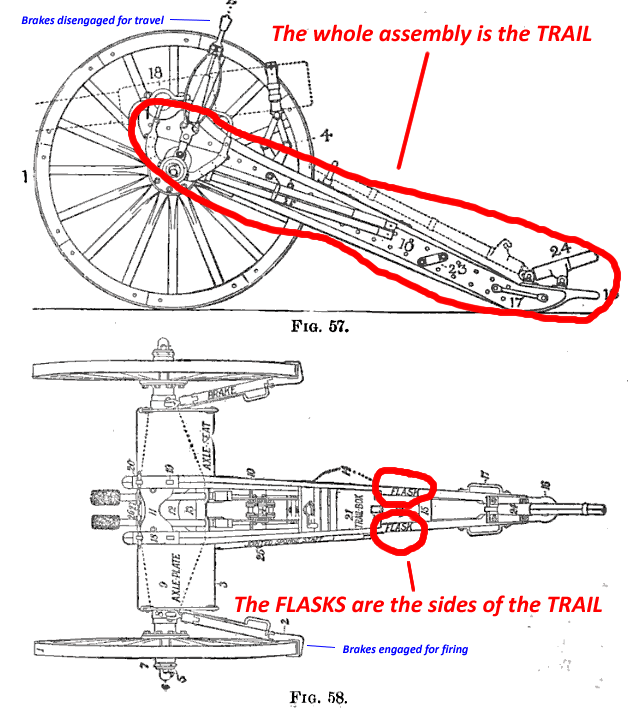
The whole supporting leg of the gun carriage is called the TRAIL. But steel was still expensive I guess, so the trail was not made as a closed box (similar to the laced beams on old bridges); the side plates of the trail are called flasks. I have no idea why. Maybe because the opening and the sides were so useful for storing stuff in and on? Beats me. But hey, I learned another new thing from this.
How can we be bored, knowing that you went to all this trouble looking up all this flotsom and jetsum. It’s WHY we come here every day Drew.Like you say Alot, politics and that shit gets old day after day after day.
 Posted by Rich K
Posted by Rich K 02/08/2013 at 04:36 PM
02/08/2013 at 04:36 PM

BTW, its not at all surprising that the Euro’s were far advanced in al things GUN,seeing as they made it a national sport from the days of the first Kings.
Posted by Rich K 02/08/2013 at 04:53 PM
02/08/2013 at 04:53 PM
 Commenting is not available in this weblog entry.
Commenting is not available in this weblog entry.
Next entry: traditional Muslim values of hospitality and tolerance .
Previous entry: Combination Challenge #69